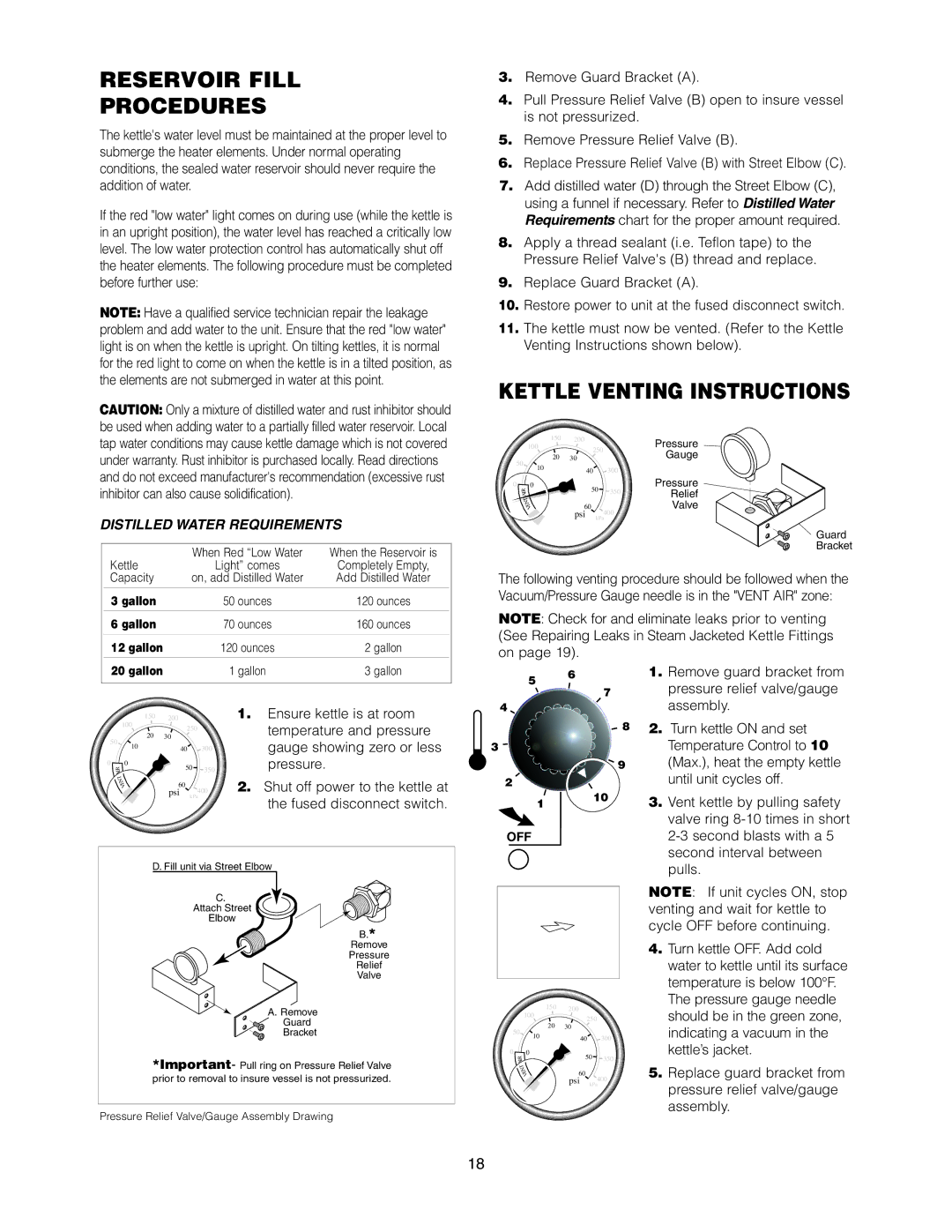
RESERVOIR FILL
PROCEDURES
The kettle's water level must be maintained at the proper level to submerge the heater elements. Under normal operating conditions, the sealed water reservoir should never require the addition of water.
If the red "low water" light comes on during use (while the kettle is in an upright position), the water level has reached a critically low level. The low water protection control has automatically shut off the heater elements. The following procedure must be completed before further use:
NOTE: Have a qualified service technician repair the leakage problem and add water to the unit. Ensure that the red "low water" light is on when the kettle is upright. On tilting kettles, it is normal for the red light to come on when the kettle is in a tilted position, as the elements are not submerged in water at this point.
CAUTION: Only a mixture of distilled water and rust inhibitor should be used when adding water to a partially filled water reservoir. Local tap water conditions may cause kettle damage which is not covered under warranty. Rust inhibitor is purchased locally. Read directions and do not exceed manufacturer's recommendation (excessive rust inhibitor can also cause solidification).
DISTILLED WATER REQUIREMENTS
| When Red “Low Water | When the Reservoir is |
Kettle | Light” comes | Completely Empty, |
Capacity | on, add Distilled Water | Add Distilled Water |
|
|
|
3 gallon | 50 ounces | 120 ounces |
6 gallon | 70 ounces | 160 ounces |
12 gallon | 120 ounces | 2 gallon |
20 gallon | 1 gallon | 3 gallon |
|
|
|
|
| 150 | 200 |
| 1. | Ensure kettle is at room |
| 100 | 250 |
|
| temperature and pressure | |
|
| 20 |
|
|
| |
50 | 30 |
|
| gauge showing zero or less | ||
10 | 40 300 |
| ||||
|
|
| ||||
0 | I |
| 50 |
|
| pressure. |
0 |
|
|
|
|
| |
| R |
|
| 350 |
|
|
| A |
|
|
|
| |
| T |
|
|
| 2. | Shut off power to the kettle at |
| N |
| 60 | 400 | ||
| E |
|
|
|
|
|
| V |
|
|
|
|
|
psi kPa
the fused disconnect switch.
D. Fill unit via Street Elbow
C.
Attach Street
Elbow
B.*
Remove
Pressure
Relief
Valve
A.Remove Guard Bracket
*Important- Pull ring on Pressure Relief Valve prior to removal to insure vessel is not pressurized.
Pressure Relief Valve/Gauge Assembly Drawing
3.Remove Guard Bracket (A).
4.Pull Pressure Relief Valve (B) open to insure vessel is not pressurized.
5.Remove Pressure Relief Valve (B).
6.Replace Pressure Relief Valve (B) with Street Elbow (C).
7.Add distilled water (D) through the Street Elbow (C), using a funnel if necessary. Refer to Distilled Water Requirements chart for the proper amount required.
8.Apply a thread sealant (i.e. Teflon tape) to the Pressure Relief Valve's (B) thread and replace.
9.Replace Guard Bracket (A).
10.Restore power to unit at the fused disconnect switch.
11.The kettle must now be vented. (Refer to the Kettle Venting Instructions shown below).
KETTLE VENTING INSTRUCTIONS
| 150 | 200 |
|
| Pressure |
100 |
| 250 |
| ||
| 20 |
|
| Gauge | |
50 | 30 |
|
| ||
10 | 40 | 300 |
| ||
|
| ||||
|
|
| |||
0 0 |
|
| 50 |
| Pressure |
I |
|
|
|
| |
R |
|
|
| 350 | Relief |
A |
|
|
| ||
T |
| 60 |
|
| |
N |
|
|
| Valve | |
E |
|
|
|
|
|
V |
| psi |
| 400 |
|
|
|
|
| ||
|
|
| kPa |
| |
Guard
Bracket
The following venting procedure should be followed when the Vacuum/Pressure Gauge needle is in the "VENT AIR" zone:
NOTE: Check for and eliminate leaks prior to venting (See Repairing Leaks in Steam Jacketed Kettle Fittings on page 19).
5 | 6 | 1. Remove guard bracket from | |
7 | pressure relief valve/gauge | ||
| |||
4 |
| assembly. |
82. Turn kettle ON and set
3 | Temperature Control to 10 |
9(Max.), heat the empty kettle
2 |
| until unit cycles off. |
1 | 10 | 3. Vent kettle by pulling safety |
|
| valve ring |
OFF |
| |
|
| second interval between |
|
| pulls. |
|
| NOTE: If unit cycles ON, stop |
|
| |
|
| venting and wait for kettle to |
|
| cycle OFF before continuing. |
4.Turn kettle OFF. Add cold water to kettle until its surface temperature is below 100°F. The pressure gauge needle
| 150 | 200 | 250 |
| should be in the green zone, |
100 |
|
| |||
|
|
|
| ||
50 | 20 | 30 | 40 | 300 | indicating a vacuum in the |
10 |
| ||||
0 |
|
| 50 |
| kettle’s jacket. |
I |
|
|
|
| |
R |
|
|
| 350 |
|
A |
|
|
| 5. Replace guard bracket from | |
T |
| 60 |
| ||
N |
|
| |||
E |
|
|
|
|
|
V |
| psi |
| 400 |
|
|
|
| pressure relief valve/gauge | ||
|
|
| kPa | ||
|
|
|
|
| |
assembly.
18
